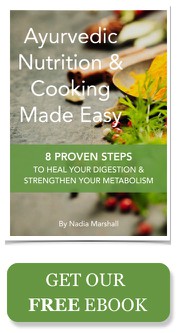By Nadia Marshall
A common question from people new to Ayurveda is... if I do this Ayurvedic thing, do I have to be vegetarian or can I still eat meat?
The answer is: Yes, you can still it meat. Happy days.
In Ayurveda, no food is eliminated, all foods are welcome. It's how often you eat certain foods that is important, along with how they are prepared.
Ayurveda is a big fan of eating predominantly vegetarian food. This is because vegetarian food is generally considered much lighter and easier to digest. It is also because vegetarian food is generally more sattvic; meaning it promotes calmness, peace and clarity in the mind. Meat, on the other hand, is considered tamasic, creating heaviness and dullness in the mind, if consumed in excess.
But this doesn't mean you can't make meat a part of your eating routine. In fact, many constitutions (particularly those with a lot of Vata) do well eating meat regularly and may feel depleted if they skip it altogether. Meat is incredibly nourishing and also very grounding so helps to pacify Vata. But, it is also very heavy so if you suffer from Vata-type indigestion (variable appetite, bloating, gas pain), it can sit a bit heavily in the belly.
The trick is to prepare meat in a way that makes it lighter and easier to digest and assimilate.... and to prepare it with other sattvic food to help lighten your 'tamas load'. But how do you do this?
One word.
Soups.
Think how your belly feels after eating a chicken parmy at the pub. Now, think how your belly feels after eating a lovely home-cooked chicken soup. That second one is the feeling we're after when it comes to eating meat.
Meat soups and bone broths are so nourishing and comforting! They are the perfect convalescing food. I would like to suggest that convalescing foods aren't just for convalesing... afterall, aren't we all in recovery from the busy-ness of our lives most of the time?! We may think we're not, but our digestive systems usually are...
If you're after something a little sexier than a meat soup, slow-cooked meat casseroles are the second best option for digestion-friendly meat eating. The third best choices are tasty morsels cooked with minced meat (think meat balls slowly sauteed in stock - for some amazing recipes, check out Yotam Ottolenghi's cookbooks). You can think of meat cooked in this way as pre-digested...a lot of the work has already been done for us!
Lighter, more active animals have lighter meats while heavier animals have heavier, fattier meats. From lightest to heaviest we're talking: fish, chicken, duck, goat, lamb, beef and finally, pork. Free range animals will also be lighter than caged animal meats and the lighter the meat, the easier it is to digest. Free range meat will also be slightly less tamasic because the animal has generally lived a more contented life...
It is super important to cook your meat with plently of herbs and spices to aid digestion. Especially turmeric. Turmeric has an anti-carcinogenic effect so helps to protect you against bowel cancer and also aids the digestion of proteins. Yay turmeric! If your meat soup, bone-broth, casserole or meat-ball recipe doesn't have turmeric in it, just add a little bit anyway - a 1/4 tsp should do to aid digestion without changing the taste of things.
I personally eat meat about once or twice a week and usually on the weekends. I try to keep things vegetarian during the week because it is easier to keep track and to not get carried away and overdo my meat eating. I also try to eat meat in the middle of the day when my digestion is strongest. Slow-cooked lamb curry for Sunday lunch anyone? Yes please!
Another hot tip... if you do eat a chicken parmy or a mega burger at the pub and find your digestion suffering as a result, don't panic or beat yourself up. Simply make your next meal a daal soup or a simple kicharee and your digestive fire will recover in no time.
And finally, here is a very tasty, easy to digest chicken soup recipe I've been making lately, during the cold and flu season...
Stock-Free Fresh Chicken Soup
Ayurveda isn't a big fan of food that isn't fresh. Stocks that we make ourselves and freeze or stocks bought from the supermarket are not fresh... so here is a super delicious stock-free chicken soup. Just as tasty and doesn't require the making of stock. Awesome!
INGREDIENTS
1 tbsp ghee or olive oil
1 onion, peeled & finely diced
4 sticks celery, diced
2 carrots, diced
2 cloves garlic, crushed and finely chopped
2 litres boiling water
1/2 tsp turmeric powder
1 tsp masala mix (equal parts ground cumin, coriander seeds & fennel seeds)
1 tbsp finely grated ginger
3 chicken thighs, cut into chunks
1 lemon, juiced
A handful of chopped flat-leaf parsley
Salt & white pepper to taste
METHOD
In a large saucepan, heat up the oil on a medium flame then add the onions. Saute until slightly golden then add the celery, carrot and garlic. Saute with the lid on for a few minutes to draw out the flavour of the veggies, stiring occassionally.
When the veggies are almost soft, add the turmeric, ginger and masala mix and fry off for about 30 seconds, then add all of the boiling water. Cook for another 3-5 minutes to infuse the flavour of the veggies and spices into the water. This is effectively making our 'stock'.
Next add the chicken pieces. Poach the chicken for 2-3 minutes then grab a stick blender and whizz up the soup so the chicken is whizzed into tiny fragments (this makes it much easier to digest). Finally, add the lemon juice, parsley, and season with salt and white pepper. Serve hot on its own (or with some rice or yeast-free breads).
Option 2: To mix it up, instead of using the carrots, try a whole fennel bulb instead, finely diced..... and then replace the parsley with finely sliced fennel fronds. A pinch of ground fennel seed goes quite nicely with this option too. Add at the same time as the turmeric. Delicious!
Serves 4-5, Gluten Free
Love
Nadia xxx
How To Eat Meat...



